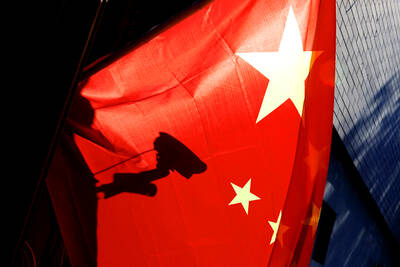North Korea’s recent rocket launch amounted to the test of a ballistic missile capable of carrying a half-tonne payload as far as the US west coast, the South Korean defense ministry said yesterday.
North Korea launched its three-stage Unha-3 rocket on Dec. 12, insisting it was a purely scientific mission aimed at putting a polar-orbiting satellite in space.
Yesterday’s estimate was based on analysis of an oxidizer container — recovered from the rocket’s first-stage splashdown site — which stored red fuming nitric acid to fuel the first-stage propellant.
“Based on our analysis and simulation, the missile is capable of flying more than 10,000km with a warhead of 500kg to 600kg,” a South Korean defense ministry official told reporters.
The estimated range of 10,000km covers the whole of Asia, eastern Europe and western Africa, as well as Alaska and a large part of the US west coast, including San Francisco.
Without any debris from the second and third stages to analyze, the official said it could not be determined if the rocket had re-entry capability — a key element of inter-continental ballistic missile (ICBM) technology.
Most of the world saw the North’s rocket launch as a disguised ballistic missile test that violates UN resolutions imposed after Pyongyang conducted nuclear tests in 2006 and 2009.
The success of the launch was seen as a major strategic step forward for the North, although missile experts differed on the level of ballistic capability demonstrated by the rocket.
The debris collected by the South Koreans was made of an alloy of aluminum and magnesium, with eight panels welded manually.
“Welding was crude, done manually,” the ministry official said, adding that oxidizer containers for storing toxic chemicals are rarely used by countries with advanced space technology.
The South’s navy later recovered three more pieces of the rocket — a fuel tank, a combustion chamber and an engine connection rod — from the Yellow Sea and has been analyzing them since Friday, Yonhap news agency said yesterday.
“As additional pieces have been salvaged, we will be able to look deeper into the function and structure of North Korea’s long-range rocket,” a South Korean defense ministry official quoted by Yonhap said.
The North apparently timed the widely condemned launch to mark the first anniversary of the death of longtime North Korean leader Kim Jong-il and drum up more support for his son and successor, Kim Jong-un.
Since the launch, Pyongyang’s propaganda machine has gone into overdrive to heap praise on the ruling Kim dynasty for leading the successful mission and to urge support for the young ruler who took over a year ago. The nuclear-armed nation has awarded medals to 101 rocket scientists and technicians who worked on the launch, its official Korean Central News Agency said yesterday.
“By successfully launching satellite Kwangmyongsong 3-2, they instilled great national self-esteem ... and dealt a sledge-hammer blow to the hostile forces’ desperate moves to check the advance of [North Korea],” it said.

SECURITY: As China is ‘reshaping’ Hong Kong’s population, Taiwan must raise the eligibility threshold for applications from Hong Kongers, Chiu Chui-cheng said When Hong Kong and Macau citizens apply for residency in Taiwan, it would be under a new category that includes a “national security observation period,” Mainland Affairs Council (MAC) Minister Chiu Chui-cheng (邱垂正) said yesterday. President William Lai (賴清德) on March 13 announced 17 strategies to counter China’s aggression toward Taiwan, including incorporating national security considerations into the review process for residency applications from Hong Kong and Macau citizens. The situation in Hong Kong is constantly changing, Chiu said to media yesterday on the sidelines of the Taipei Technology Run hosted by the Taipei Neihu Technology Park Development Association. With

A US Marine Corps regiment equipped with Naval Strike Missiles (NSM) is set to participate in the upcoming Balikatan 25 exercise in the Luzon Strait, marking the system’s first-ever deployment in the Philippines. US and Philippine officials have separately confirmed that the Navy Marine Expeditionary Ship Interdiction System (NMESIS) — the mobile launch platform for the Naval Strike Missile — would take part in the joint exercise. The missiles are being deployed to “a strategic first island chain chokepoint” in the waters between Taiwan proper and the Philippines, US-based Naval News reported. “The Luzon Strait and Bashi Channel represent a critical access

‘FORM OF PROTEST’: The German Institute Taipei said it was ‘shocked’ to see Nazi symbolism used in connection with political aims as it condemned the incident Sung Chien-liang (宋建樑), who led efforts to recall Democratic Progressive Party (DPP) Legislator Lee Kun-cheng (李坤城), was released on bail of NT$80,000 yesterday amid an outcry over a Nazi armband he wore to questioning the night before. Sung arrived at the New Taipei City District Prosecutors’ Office for questioning in a recall petition forgery case on Tuesday night wearing a red armband bearing a swastika, carrying a copy of Adolf Hitler’s Mein Kampf and giving a Nazi salute. Sung left the building at 1:15am without the armband and apparently covering the book with a coat. This is a serious international scandal and Chinese

COUNTERINTELLIGENCE TRAINING: The ministry said 87.5 percent of the apprehended Chinese agents were reported by service members they tried to lure into becoming spies Taiwanese organized crime, illegal money lenders, temples and civic groups are complicit in Beijing’s infiltration of the armed forces, the Ministry of National Defense (MND) said in a report yesterday. Retired service members who had been turned to Beijing’s cause mainly relied on those channels to infiltrate the Taiwanese military, according to the report to be submitted to lawmakers ahead of tomorrow’s hearing on Chinese espionage in the military. Chinese intelligence typically used blackmail, Internet-based communications, bribery or debts to loan sharks to leverage active service personnel to do its bidding, it said. China’s main goals are to collect intelligence, and develop a